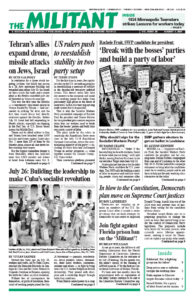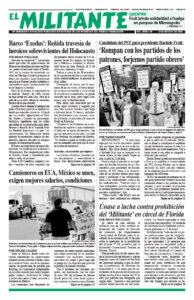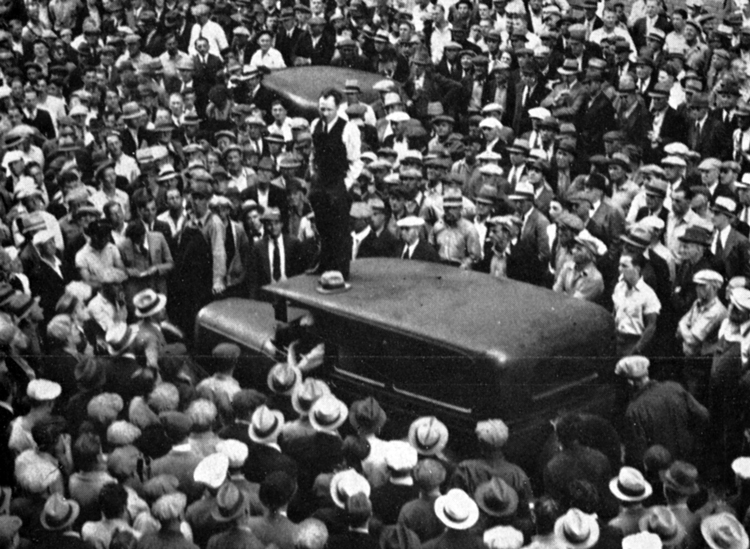July marks the 90th anniversary of the 1934 Teamsters strikes in Minneapolis that won union recognition for General Drivers Local 574 and paved the way for successful union battles throughout that city and region. The lessons of this fight, led by class-struggle militants and communist workers, are as relevant today as they were then.
That strike was a continuation of earlier fights by rank-and-file workers that year, including a disciplined and successful battle in the streets with cops and company goons in May. It was one of three titanic labor victories in the summer of 1934. The others were by striking auto parts workers in Toledo, Ohio, and West Coast longshoremen, who waged a three-month strike to win union recognition.
Together they marked a sharp break from years without labor battles following the 1929 stock market crash and ensuing capitalist economic crisis, transforming what workers nationwide believed they could accomplish. They paved the way for forging the Congress of Industrial Organizations a few years after, which organized hundreds of thousands of workers who won union recognition and made advances in class-struggle battles with the bosses in the mines, auto, steel, packinghouses, oil and other basic industries.
Teamsters Local 574 was strengthened through forging a broad leadership team that drew the rank and file into responsibility for the actions of the union. The workers reached out and won support from the unemployed, who were organized as an auxiliary section of the union, known as the Federal Workers Section. They had full support of the union in their fight for jobs and decent working conditions, and they joined the Teamsters on the picket lines in their battles with the bosses.
The union also reached out and won support from other workers in the city, as well as farmers, women and owner-operator truck drivers. In an act of solidarity, when Local 574 went on strike they leased a parking lot so market gardeners, working farmers who sold their produce to small grocers, could continue working. The local also launched a women’s auxiliary that organized a commissary and staffed the strike hospital that treated wounded pickets. The auxiliary also organized trips around the region, speaking to win support for the strike.
To refute lies by the bosses and point a road forward for the union and the working class as a whole, Teamsters Local 574 published an official union paper, the Organizer, which appeared daily in mid-July for the duration of the monthlong strike.
The union continued to publish the paper, subsequently known as the Northwest Organizer, throughout the 1930s. It took up broader social and political issues facing the working class — demanding the Franklin Roosevelt administration grant refuge for Jews fleeing Nazi persecution, fighting FBI frame-ups of unionists, opposing Washington’s preparations for the second imperialist World War and posing the need for independent working-class political action.
The local also set an example by initiating a 600-member Union Defense Guard, formed by volunteers from the Teamsters and other unions in Minneapolis and St. Paul, that successfully drove the employer-funded fascist group Silver Shirts out of the area in 1938. The bosses had brought the thugs to town that year aiming to unleash them to bust the unions and promote Jew-hatred.
The victories won by the Teamsters in Minneapolis led to an 11-state over-the-road campaign that brought tens of thousands of truckers into the union. These efforts helped make the Teamsters one of the main industrial unions in the U.S., which it remains today.
The story of the Teamster battles in the 1930s and the class-struggle leadership forged in Minneapolis is told by Farrell Dobbs in a four-volume set of books. They are an invaluable source of inspiration for use by class-struggle minded workers today.
Dobbs emerged from the ranks to become a leader of the 1934 Teamster strikes and director of the over-the-road campaign. He became a leader of the Socialist Workers Party, serving as its national secretary from 1953 to 1972, and as the party’s candidate for president in 1948, 1952, 1956 and 1960.
————————————————————————
Farrell Dobbs: For a party of labor based on the unions
Below is an excerpt from the Afterword to Teamster Bureaucracy by Farrell Dobbs. It takes up why workers need to form our own party, a party of labor. Copyright © 2018 by Pathfinder Press. Reprinted by permission.
Whenever conflicts of significant magnitude erupt within industry today, the government intervenes on the employers’ side; and this interference is bound to intensify as capitalist decay gets worse. From this it follows that trade union action alone will prove less and less capable of resolving the workers’ problems, even on a limited basis. Objectively, industrial conflicts will assume more and more a political character, and even the most powerfully organized workers will be faced with an increasingly urgent need to act on the new and higher plane of politics.
Therefore, efforts to build an effective left wing in the trade unions will run into insurmountable obstacles unless the workers move toward resolving the problem of political action. A vigorous campaign must be conducted to break the labor movement from subordination to capitalist politics and to launch an independent labor political organization. This campaign will have to focus initially on educational propaganda for a change in labor’s political course, but it should not be conducted in an abstract, routine manner. Ample opportunity will be found to concretize the propaganda by drawing the lessons of setbacks caused by the misuse of labor’s inherent political strength. This can lay the basis for an advance, as soon as it becomes realistic, to an agitational campaign designed to convince the ranks of the urgency of forming a labor party.
In the process of creating their own mass party, based upon and controlled by the trade unions, the organized workers can draw unorganized, unemployed, and undocumented sections of their class into a broad political alliance. Labor will then be in a position to act both in a more unified manner and through advanced forms of struggle.
The workers will learn to generalize their needs, as a class, and to address their demands on a political basis to the capitalists, as a class. Political confrontation of that kind — for example, the nationalization of a given industry under workers’ control — will raise labor action as a whole to a higher plane and at the same time impart new vigor to the continuing trade union struggles. Increased militancy within industry will serve, in turn, to reinforce activity in the political sphere. In that way interacting processes will develop through which the workers will attain greater class consciousness, more complete solidarity, and, hence, mounting ability to outfight the bosses.


